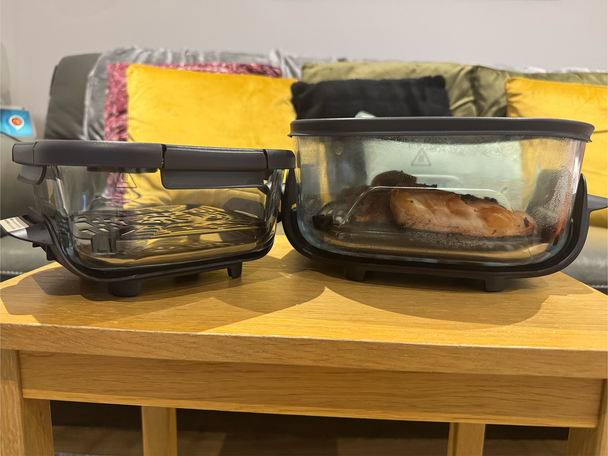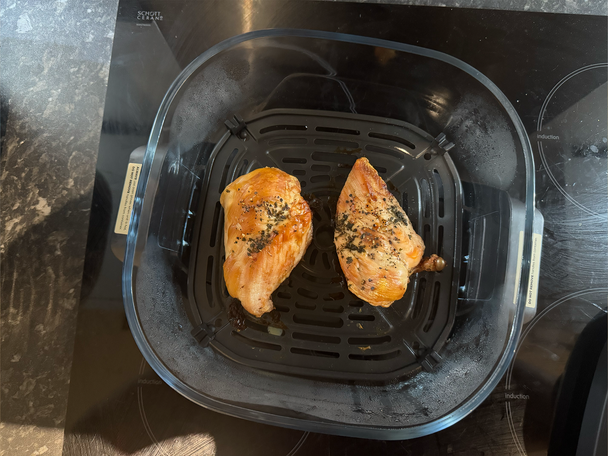ARTICLE AD BOX
“Gosh! This all looks rather overwhelming, doesn’t it?” Those were my exact thoughts as I opened the box. This is no ordinary air fryer – there’s no standard base unit that you just pull out and plug in. Instead, it’s a modular setup with multiple components, which might seem daunting at first but starts to make sense quickly.
Design and setup
Inside the box, you’ll find a range of different pieces: a detachable heating lid (the PowerPod), two thermal-shock-resistant glass bowls (1.4l and 3.8l), an adapter that fits onto the larger bowl, and two crisper plates that slot inside them both for cooking. There are also two storage lids, which let you keep leftovers in the same bowl you cooked in – a surprisingly handy touch.
 There are so many elements, it's easy to get overwhelmed, but it's simpler than you might think (Alex Lee)
There are so many elements, it's easy to get overwhelmed, but it's simpler than you might think (Alex Lee)While it might seem like a lot at first, everything has a clear purpose, and it’s really easy to put this air fryer together and take it apart for storage. Once you get the hang of how everything fits together, it’s unbelievably compact – so much so that I didn’t really want to go back to air frying in a regular machine after testing this one. There’s just something about cooking in a modular, see-through system that feels a little like magic.
The PowerPod lid is the crucial bit – it houses the heating element and fan responsible for circulating hot air and crisping up your grub. Unlike traditional air fryers, there’s no bulky base unit – just this detachable lid, making the whole system lighter to cart around. The PowerPod features a simple interface on top, letting you choose from four cooking modes: air fry, roast, re-crisp, and keep warm. There’s no manual temperature control – each mode operates at a preset temperature optimised for that cooking method, but you can adjust the time.
 There are four different cooking modes to choose from (Alex Lee)
There are four different cooking modes to choose from (Alex Lee)If you’re using the smaller 1.4l glass bowl, the PowerPod simply rests on top but doesn’t lock into place. For the larger 3.8l glass bowl, you’ll need to use the adapter. This ring-like attachment sits on top of the bowl, and the PowerPod clicks into place. Unlike the smaller bowl, the PowerPod fits more securely. The benefit of having two different bowls is that you can more easily cater for different meals.
The glass containers also have heat-resistant feet, so there’s no risk of scorching your lovely countertops. The PowerPod, however, does get quite hot after cooking. As there’s no base unit, when I lift the lid, I usually place it upside down on the countertop so the hot surface isn’t resting directly on my work surface. It won’t burn anything, but I’d rather not have something that warm sitting there.
Once your food is cooked, you simply pull off the PowerPod lid, then pop on a storage lid when you’re ready to store your food in the fridge – really handy for meal prep. One of the best things about the Ninja Crispi is how neatly everything packs away. The glass bowls stack inside each other, the storage lids fit neatly on top, and the PowerPod sits right above them, forming one tidy, nestable unit.
 The glass bowls double up as storage containers (Alex Lee)
The glass bowls double up as storage containers (Alex Lee)Cooking
Honestly, being able to see your food cooking in this little machine is a marvel. If you’ve got lighter foods, such as chips, you’ll see them flying around inside as if they were bits of corn being popped. Apparently, this is what actually happens inside an air fryer – you just can’t see it happening in action because of your opaque drawers. Not going to lie, it’s quite a delight.
In terms of performance, the Ninja Crispi handled cooking really well. I mostly used the air fry mode, which worked as well as any other Ninja device. I got golden and crispy chips without needing to shake them constantly, while a seasoned chicken breast dish came out tender and juicy, and nuggets developed a nice crunch on the outside. Since you can see everything through the glass, there’s never any second-guessing as to when your food is crisped to perfection.
 Chicken came out nice and tender and juicy (Alex Lee)
Chicken came out nice and tender and juicy (Alex Lee)The re-crisp mode is surprisingly handy, too. It’s great for bringing chips and fried foods back to life when they’ve gone a bit soggy. Leftover pizza is a standout – it revives beautifully, with a crispy base and melty cheese, rather than turning into a sad, chewy mess.
As for the roast function, it’s OK – but not as good as just air-frying. Roasted potatoes still came out crispy, but they took a little longer than expected, and I didn’t notice a huge difference compared with just using the air fry mode. If you’re expecting an oven-style roast, you might be disappointed.
The keep warm mode is also one of those functions that seems unnecessary until you start using it. It’s great for holding food at the right temperature while you finish prepping a meal. I left some roasted potatoes sitting in there for about 20 minutes, and they stayed warm without overcooking or turning soggy.
 Re-crisping leftover pizza in the air fryer worked a treat (Alex Lee)
Re-crisping leftover pizza in the air fryer worked a treat (Alex Lee)That said, the bowl sizes might be a bit of a sticking point. The smaller 1.4l bowl is great for reheating leftovers or chucking in a handful of chips, but it’s not big enough for much else. The larger 3.8l bowl is decent for roasting veg or cooking a main, but if you’re feeding more than two people, you’ll probably need to cook in batches. What’s good about the modular system, though, is that Ninja could technically bring out larger containers in the future. That’s something I’d really like to see, given it’s already such a flexible system.
Cleaning
This model is much easier to clean than a regular air fryer, thanks to its modular system and glass container design with a lid that detaches easily. The crisper plates are also dishwasher-safe, and even the adapter can be chucked in the dishwasher. Because everything comes apart, I could just as easily wash it all by hand – sometimes taking crisper plates or drawers out of regular air fryers is such a faff that I end up neglecting to clean them as regularly as I should.
If you’re feeling extra lazy, I even lined the bottom of the bowls with air fryer-safe paper, and my food still came out nice and crisp. No grease stuck on the crisper plates – just lift the paper out, and you’re done.









 English (US) ·
English (US) ·